Positive Outlook for Outsourcing
Contract services ride high as funding floods bio/pharma.

Early-stage and mid-size bio/pharmaceutical companies have enjoyed an embarrassment of riches over the past 18 months. The window for initial public offerings (IPOs) re-opened, at least for a while. Global bio/pharmaceutical companies continued their frenzied pace of partnering and acquisition activity, and venture capital spiked up as the prospects improved for rich exits.
Because the contract services industry floats on the tide of external funding to a large degree, one would expect the bio/pharmaceutical contract services industry to be doing well in this robust funding environment. The results of the 2014 edition of the PharmSource/Pharmaceutical Technology Outsourcing Survey, conducted in June 2014, confirm that expectation. Bio/pharmaceutical company respondents reported strong growth in spending on contract services this year (Figure 1). Among that group, 19% said their company’s spending on contract services in 2014 is at least 20% higher than in 2013; the comparable figure in the 2013 survey was only 12%. Another 17% of 2014 respondents said their company’s spending is up at least 10%, about the same as last year. Only 9% indicated that spending had declined year-over-year.
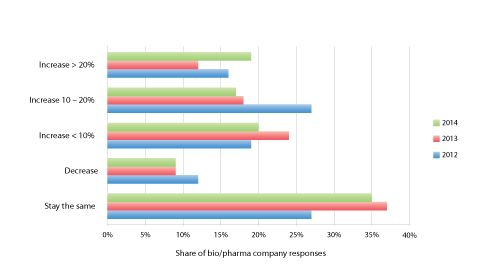
As in past years, bio/pharma respondents reported that contract services expenditures are growing at the same rate as total spending, but that trend is more pronounced than in past years (Figure 2): 52% of bio/pharma respondents indicated that outsourced spending is growing at the same rate as total spending versus 42% last year and 39% the year before. Only 20% indicated that expenditures on contract services are growing faster than total spending, down from 29% in 2013.
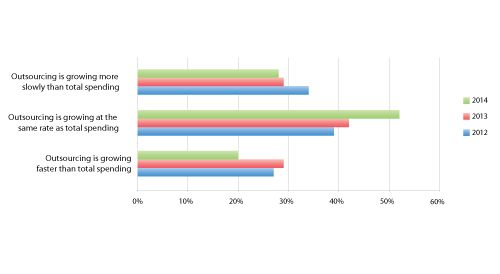
Very good year for CDMOs
As expected, responses from contract service providers confirmed that they are enjoying a strong 2014. Of the total responses from that group, 32% characterized 2014 as “Very Good”, up from 20% in 2013. Further, only 5% of contractor respondents characterized this year as “Not Very Good” compared to 15% in 2013.
Most contract service providers were expecting 2014 to be a good year but those expectations may have been somewhat muted after disappointments in 2013. In the 2013 survey, 25% of CMO/CDMO respondents indicated that the year’s activity was “Worse than Expected” but only 12% have been similarly disappointed this year. Fifty percent said this year’s performance has been “As Expected” while 38% indicated it was better than expected.
As in past years, contract service providers singled out mid-size and specialty bio/pharma companies as the main drivers of business success for this year (Figure 3), but there has been a big surge in the performance of small bio/pharma companies: 23% of contractor respondents identified small bio/pharma companies as their best-performing customer segment versus just 5% in 2013. This surge is consistent with what would be expected from the robust funding environment: smaller companies have been beneficiaries of improved venture capital and partnering funding, while mid-size and specialty companies benefit from improved public equity markets and partnering. The significance of generic-drug companies declined: only 18% of CDMO respondents identified them as their best performers, versus 28% last year.
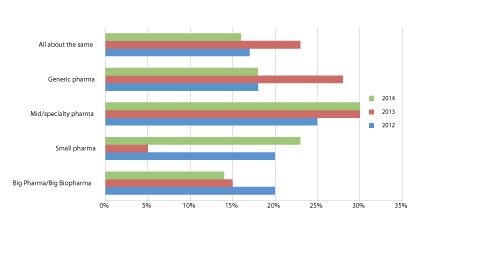
Business risks
With demand for their services strong, service providers have not been as aggressive in soliciting new business as they have in past years. Among bio/pharma respondents, twice as many indicated that service providers “Are not asking for new business”: 27% in 2014 versus 13% in 2013. Further, bio/pharma respondents indicated that service providers are less willing to negotiate prices than in past years: 34% indicated that service providers “want new business but will not cut price to get it” up from 30% in 2013.
For service providers, the risk of losing clients as bio/pharma companies consolidate their supplier base remains high: 43% of bio/pharma respondents said they have reduced or plan to reduce the number of vendors they work with, the same as 2013. Interest in working with CMOs and CDMOs in India and China, in particular, continues to decline. Fifty percent of bio/pharma company respondents indicated they have no plans to source from those countries, up from 41% in 2013 and 33% in 2012 (Figure 4).
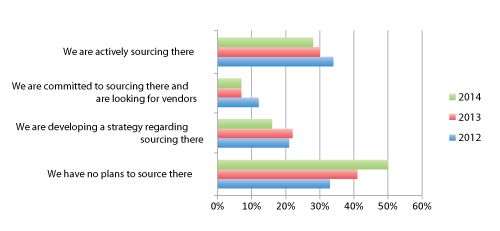
Interestingly, while bio/pharma companies say they are less interested in sourcing from India and China, service providers still see that as the biggest risk to their business (Figure 5). Their concern about continued funding for development activities, however, has drawn almost even with the India/China concern: 20% identified cuts in spending at global bio/pharma companies as the biggest risk to their business, double the number in 2013, while 23% focused on the risk of reduced funding for early-stage companies. Clearly, the service provider respondents understand that the external financing environment and global bio/pharma’s need for new products are driving their success.
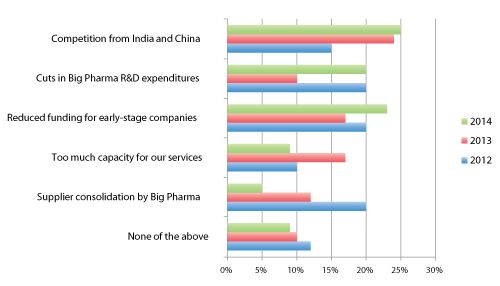
We continue to poll the industry on perceptions of service provider performance. In 2014, as in past years, there is a significant gap between how customers see CMO/CDMO performance and how they see themselves (Figure 6). The big gaps continue to be in the “soft” areas of project management and customer service, but there is greater satisfaction with levels of technical and operational performance.
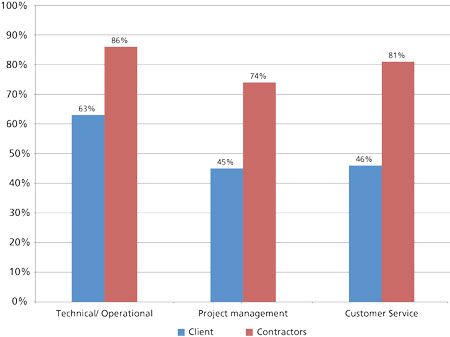
Customer expectations indicate that 2015 should be another good year for the contract services industry (Figure 7). One-third of bio/pharma company respondents expect their spending to increase by 10% in 2015, the same percentage as in the 2013 survey. Only 11% expect spending to decrease while most anticipate spending to be the same or slightly higher in 2015.
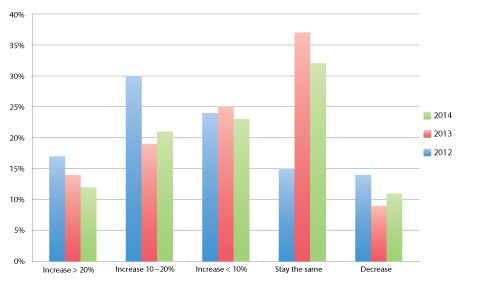
What it means
Overall, the 2014 edition of the PharmSourcePharmaceutical Technology Outsourcing Survey paints a positive picture of the contract services industry: spending is up, pricing has firmed, and the risks of low-cost overseas competition have diminished.
A closer look at the data, however, suggests some red flags that CMOs and CDMOs should heed carefully. In particular, the survey respondents suggest that the contract services industry’s success is largely a result of the improved financial environment, rather than an increased acceptance of outsourcing. This belief is borne out by the fact that for the majority of bio/pharma company respondents, their contract services spending is growing at the same rate as their total spending; and by the big surge in the importance of small bio/pharma companies as drivers of growth for service providers.
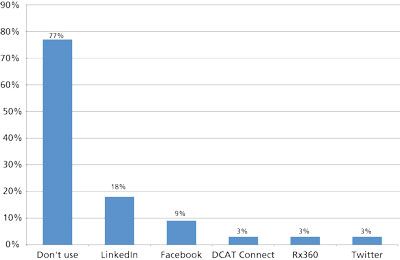
The reliance on smaller companies is concerning for three reasons. For one, funding for early-stage companies tends to be highly cyclical, with periods of robust financing followed by periods of relative drought, so it cannot be a driver of consistent performance. Further, because the preferred early-stage bio/pharma business model is to be totally or highly virtual (i.e., nearly all of their development activity is outsourced), there is little or no room for growth by getting them to outsource more than they already do. Finally, because investors in an early-stage company are generally looking to sell the company or out-license its candidates to larger companies, most early-stage companies do not offer long-term revenue streams.
In the clinical research sector, the largest and best-performing CROs are those that have formed strategic sourcing relationships with global bio/pharma companies, which have the biggest pipelines and deepest pockets. Those relationships have been harder to create for CDMOs and CMOs because global bio/pharma companies continue to show a preference for in-house manufacturing and development, especially for high-margin products like biologics. A recent PharmSource study found that between 2010 and 2013 bio/pharma companies spent $114 billion on new facilities and equipment, despite the global financial crisis and demand for cash to fund acquisition and licensing deals (1).
CMOs and CDMOs should enjoy this unusual, central-bank driven tidal wave of industry funding, but must remain aware that they can’t expect it to go on forever. In particular, they need to make sure they continue to cultivate client relationships and battle for new business, and not just answer telephone and e-mail inquiries.
Reference
1. PharmSource, “Make vs. Buy: Bio/Pharma Capital Expenditure Trends and Implications for Contract Services” (July 2014).

About the Author
Jim Miller is president of PharmSource Information Services, Inc., and publisher of Bio/Pharmaceutical Outsourcing Report, tel. 703.383.4903, info@pharmsource.com,
www.pharmsource.com.
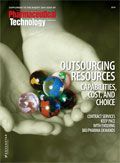
Drug Solutions Podcast: A Closer Look at mRNA in Oncology and Vaccines
April 30th 2024In this episode fo the Drug Solutions Podcast, etherna’s vice-president of Technology and Innovation, Stefaan De Koker, discusses the merits and challenges of using mRNA as the foundation for therapeutics in oncology as well as for vaccines.
Pharmaceutical Tariffs Are Imminent: How Industry is Bracing for Impact
April 16th 2025On April 14, 2025, the Trump Administration launched a national security-driven investigation into pharmaceuticals, a move that will likely result in tariffs being placed on pharmaceutical drugs, ingredients, and other components that are imported from outside of the United States.